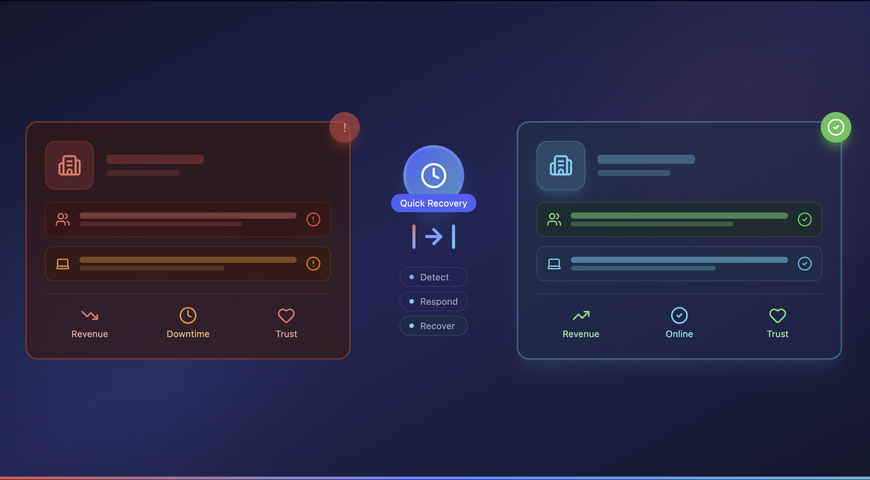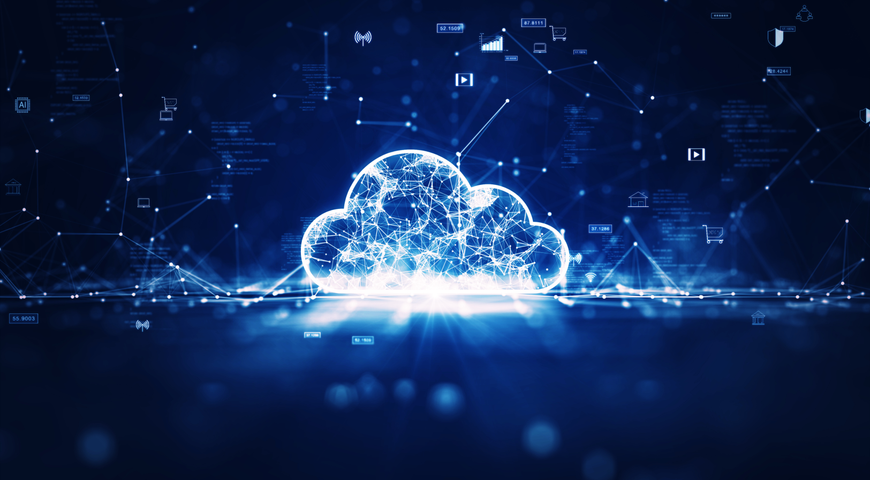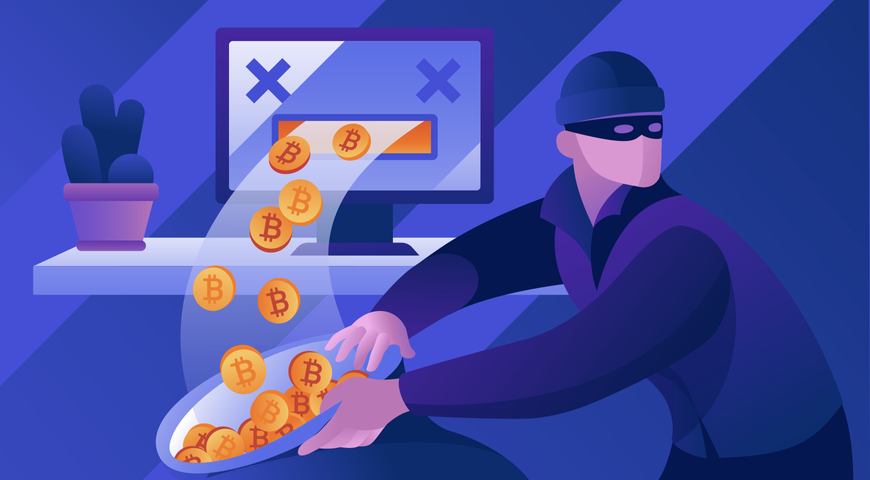
What Is Cyber Resilience? Answering the How, Why, and Key Differences
Blocking every attack is impossible. The real question is this: how fast can your clients recover when one gets through?
The reality is that cyberattacks are no longer a matter of “if” but “when.” For managed service providers (MSPs), this shift has redefined client expectations. While strong cybersecurity measures are essential, they are no longer sufficient on their own. What clients need is cyber resilience.
Cyber resilience moves beyond prevention to ensure continuity. Traditional cybersecurity focuses on building barriers to keep attackers out, but it cannot guarantee 100% protection. Attack techniques evolve constantly, with cybercriminals finding new ways to bypass defenses.
Cyber resilience acknowledges this reality and asks a more critical question: how do you minimize damage, maintain operations, and recover quickly when an attack inevitably succeeds?
This guide is built for MSPs to answer the most common questions about cyber resilience. We will cover what it means in practical terms and how it differs from cybersecurity, and we’ll provide a framework you can implement to strengthen your clients’ ability to withstand and recover from disruption.
Why is this Shift Important?
The importance of resilience becomes clearer when viewed through recent industry statistics:
- 35% of ransomware attacks start with phishing emails (source: Keepnet, 2025). With phishing still the leading entry point, a single employee mistake can trigger a serious incident.
- 1.2% of all global emails are malicious (source: Keepnet, 2025). While this looks small, global email volume translates this into millions of dangerous messages daily.
- 59% of organizations experienced ransomware attacks in 2023 (source: Spacelift, 2025). This shows that most businesses will be targeted, not just large enterprises.
- Average ransom demands hit $2.73 million in 2024 (source: Spacelift, 2025). For SMBs, this can be financially crippling.
- Average downtime after a cyberattack is about 24 days (source: Spacelift, 2025). Nearly a month offline severely impacts revenue, productivity, and compliance.
- Downtime costs organizations between $5,600 and $9,000 per minute (source: DotSecurity, 2024). Even brief outages result in heavy financial losses.
For MSPs, these statistics are more than abstract numbers. They underscore why clients need a resilience-first strategy. Cyber resilience is not just about defending against threats but also ensuring your clients can keep operating, serving customers, and protecting their reputation even during an attack.
What Is Meant by Cyber Resilience?
Cyber resilience is an organization’s ability to anticipate, withstand, recover from, and adapt to cyberattacks or IT disruptions. It is a holistic strategy that accepts a simple truth: no defense is impenetrable.
Instead of betting everything on prevention, cyber resilience prepares for the moment when, not if, a breach occurs. The focus shifts to limiting damage, restoring operations, and learning from the incident so the organization becomes stronger with each challenge.
For MSPs, this definition is especially relevant. Your clients expect strong cybersecurity, but what they truly value is continuity. A client whose email is locked down for 24 hours or whose customer-facing application is offline for a week risks losing revenue, trust, and even compliance standing.
Cyber resilience gives MSPs a framework to meet these expectations by blending proactive defense with rapid recovery and continuous improvement. In other words, while cybersecurity helps your clients avoid falling, cyber resilience ensures they can get back up quickly and keep moving.
To break this down, cyber resilience can be understood through four key aspects.
1. Anticipate & Withstand
The first stage of resilience is about proactive preparation. Cyberattacks are inevitable, but hardening systems can reduce their impact before threats strike. So, organizations must proactively identify risks, patch vulnerabilities, and build robust systems designed to endure an attack without total collapse.
For MSPs, this means putting in place multi-layered defense strategies across client environments. Redundancy in critical systems, zero-trust access policies, and continuous monitoring all fall under this category. By anticipating threats, you reduce the blast radius of any single incident.
Solutions like Acronis Cyber Protect Cloud (ACPC) are designed with this principle in mind. They integrate data protection with advanced anti-malware, vulnerability assessments, and patch management. This allows MSPs to not only secure systems but also build durability into the very architecture of their clients’ IT.
For example, if a phishing email introduces malware, a client with ACPC in place has multiple layers of protection that reduce the likelihood of the attack spreading widely.
2. Respond & Detect
Even the most robust defenses will occasionally fail. When that happens, speed matters. Resilience requires organizations to rapidly identify a security incident as it happens and execute a plan to contain the threat immediately. Without early detection and a structured response, even a small breach can escalate into a full-blown disaster.
For MSPs, this step highlights the value of active monitoring and incident response planning. It is not enough to have security alerts in place. Clients need assurance that you can act immediately when a breach occurs.
Well-defined playbooks, automated containment actions, and guided remediation steps ensure that detection leads directly to decisive action.
Acronis Endpoint Detection and Response (EDR) is built to support MSPs in this area. It provides real-time visibility into client endpoints, advanced detection of suspicious behavior, and automated response actions to stop threats in their tracks.
Imagine a ransomware attack spreading through a client’s network. With EDR, you can isolate the affected machines instantly, preventing further infection and buying time for recovery.
3. Recover
Resilience is most visible in the recovery stage. After a cyber incident, the priority becomes restoring systems and data to a secure, operational state with minimal downtime, using tools like backup and disaster recovery. This is the moment that defines whether a client experiences minor disruption or catastrophic downtime.
For MSPs, your clients depend on you to restore their environments without data loss and with minimal impact on business continuity. Backup solutions, disaster recovery planning, and automated failover are essential components of this capability.
Acronis Cloud Disaster Recovery provides MSPs with the tools to deliver this assurance. It can replicate client systems and spin them up in the cloud. This allows businesses to continue operating even when their primary infrastructure is compromised. Instead of waiting days or weeks to resume operations, clients can be back online in minutes.
4. Adapt
Cyber resilience does not end with recovery. Every incident leaves behind valuable lessons. This final stage is about learning from every incident. Use forensics to understand the attack vector and improve defenses to prevent future occurrences.
For MSPs, this stage demonstrates long-term value. You’re not only helping clients bounce back; you’re also making them better prepared for the future.
By running post-incident reviews, updating policies, and applying lessons learned across your client base, you turn each crisis into an opportunity for improvement.
Services like Acronis Managed Detection and Response (MDR) extend this capability by providing 24/7 expert oversight and continuous tuning of defenses.
For more information, you can check out an article called “What is Managed Detection and Response (MDR)? The complete 2025 guide.”
What Is the Difference Between Cyber Security and Cyber Resilience?
The easiest way to think about it is that cybersecurity tries to prevent a car crash, while cyber resilience is the seatbelt, airbags, and emergency response plan that ensure you survive the crash. Both are essential, but they serve different purposes in keeping organizations safe.
For MSPs, this distinction is critical. Clients often assume that investing in cybersecurity alone is enough. While strong cybersecurity practices help minimize the risk of a breach, they do not guarantee business continuity. Cyber resilience fills that gap by ensuring organizations can withstand, recover, and adapt when an incident inevitably occurs.
Here is a simple comparison to illustrate the difference:
Cybersecurity provides the shield that keeps attackers out, while cyber resilience ensures the organization can keep going if that shield is pierced. For MSPs, delivering both is the foundation of protecting clients from financial loss, downtime, and reputational damage.
The Steps to Cyber Resilience: A Practical Three-Stage Framework
While comprehensive frameworks like the seven-step NIST model are the gold standard, MSPs can implement these principles through a streamlined three-stage service lifecycle. MSPs often need a streamlined, service-oriented approach they can implement directly in client environments.
This lifecycle simplifies resilience into clear, repeatable processes that cover preparation, defense, detection, response, and recovery.
1. Identify & Prepare
This first step involves laying the groundwork for resilience by proactively identifying risks and preparing defenses before an attack occurs.
MSPs need to understand where risks exist, prioritize which assets matter most, and set up for fast recovery.
Key elements of this stage include the following:
Backup & Recovery
Ensure reliable, immutable copies of critical workloads are always available. A cyber resilience strategy is only as strong as its backups. MSPs must provide backup and recovery of critical workloads that cannot be altered by ransomware.
This ensures data can always be restored, regardless of the attack vector. Acronis Cyber Protect offers immutable storage and integrated backup management, giving MSPs confidence that client data is safe.
OS Vulnerability Assessment
You’ll also need to detect and patch weaknesses before attackers exploit them. Many breaches happen because of unpatched vulnerabilities.
By proactively scanning for weaknesses and applying timely patches, MSPs close doors before attackers exploit them. Acronis Cyber Protect automates vulnerability assessments, enabling you to move clients from reactive patching to proactive protection.
Next-Generation Anti-Malware
Finally, you’ll want to block known and unknown threats with AI-driven protection. Traditional signature-based antivirus is no longer enough.
MSPs need these AI-powered solutions to protect themselves against threats. Acronis Cyber Protect integrates advanced anti-malware into its backup and protection suite, reducing the number of silos you need to manage.
MSP Advantage: By preparing clients before a threat strikes, you lower risk exposure and establish yourself as a trusted partner who anticipates challenges rather than reacting to them.
2. Protect & Detect
The second stage in the cyber resilience framework is to defend critical assets and rapidly detect malicious activity that bypasses initial defenses.
Even the best-prepared defenses will eventually be tested. This stage focuses on safeguarding critical assets and ensuring you can detect threats the moment they emerge.
Critical capabilities include the following:
Database & Cluster Protection
First, you’ll need to secure specialized workloads against targeted exploits. Business-critical applications such as SQL clusters or specialized databases are often prime targets for attackers.
Acronis Cyber Protect provides workload-specific defenses to ensure these systems remain online and uncompromised.
Endpoint Detection & Response (EDR)
Next, monitor and contain threats at the device level. With the rise of hybrid work, endpoints have become one of the weakest links in security. EDR continuously monitors devices, identifies malicious behaviors, and contains threats before they spread. Acronis EDR integrates seamlessly with existing backup and protection workflows.
Extended Detection & Response (XDR)
You’ll also need to correlate activity across endpoints, email, network, and cloud for full visibility. While EDR covers endpoints, modern attackers often move laterally across networks, email systems, and cloud services. Acronis’ AAA award-winning XDR provides cross-platform visibility, correlating signals across the IT environment to stop advanced persistent threats.
MSP Advantage: Instead of delivering siloed point solutions, you provide clients with a unified protection and detection stack that balances prevention with situational awareness.
3. Respond & Recover
The third stage involves containing threats quickly and restoring business operations with minimal downtime. When incidents happen (and they will), the speed and efficiency of your response is what determines client satisfaction.
Cloud Disaster Recovery (DR)
Fail over critical systems within minutes to maintain continuity with cloud disaster recovery. Clients cannot afford extended outages.
With Acronis Disaster Recovery, MSPs can fail over workloads to the cloud within minutes, ensuring clients remain operational even during major disruptions.
Remote Monitoring & Management (RMM)
You’ll next want to centralize incident remediation and ongoing system health checks with RMM. To respond effectively, MSPs need centralized visibility across systems.
Acronis RMM (which won the CRN Tech Innovator Award) enables real-time incident remediation, patch deployment, and ongoing system health monitoring, reducing time wasted on manual tasks.
AI-Infused Backup Validation
Lastly, you’ll want to guarantee data integrity by ensuring recoverability before an attack strikes. Backups are only useful if they work when needed.
Acronis Cyber Protect uses AI to automatically validate backup integrity, ensuring data is recoverable before an incident occurs. This reduces the chance of discovering broken backups at the worst possible moment. You can learn more about why Acronis Cyber Protect is an AV-TEST top product here.
MSP Advantage: By guaranteeing rapid recovery and verified backup integrity, you deliver not just security but also business continuity. This is something clients directly measure in revenue saved and downtime avoided.
How Do You Achieve Cyber Resilience? A Three-Pillar Strategy
Achieving true cyber resilience is not about buying more security tools or adding another firewall. It requires a balanced strategy built on three interdependent pillars: people, process, and technology. For MSPs, these pillars provide a blueprint for delivering consistent, measurable resilience across diverse client environments.
To bring it all together, MSPs also need a business continuity and disaster recovery (BCDR) framework that makes resilience practical, quantifiable, and client-focused.
Let’s now break down the three pillars, connect them to actionable steps, and show how to integrate them into a structured resilience program.
Pillar 1: People (Your Human Firewall)
Technology may stop many threats, but employees remain both the strongest defense and the weakest link. Social engineering and phishing continue to dominate as entry points for attackers.
According to Keepnet, 35% of ransomware attacks begin with phishing emails, and 1.2% of all emails sent worldwide are malicious. For MSPs, empowering client teams with the knowledge and awareness to act as a human firewall is essential.
Here are some potential actions for MSPs:
Implement Continuous Security Awareness Training
Attackers refine their methods constantly, from AI-generated phishing emails to deepfake voice scams. Regular, scenario-based training ensures employees can recognize and report suspicious activity, keeping defenses current.
Define Clear Roles in the Incident Response Plan (IRP)
During a cyberattack, time wasted on figuring out “who does what” can mean the difference between a contained event and catastrophic downtime. MSPs should work with clients to assign responsibilities in advance, covering communication, escalation, and technical remediation.
Enforce Strong Access Control Policies
Human error can be reduced significantly with technical safeguards. Require least privilege access, enforce multi-factor authentication (MFA), and audit user permissions regularly to ensure employees only have access to what they truly need.
Acronis Solution for Pillar 1:
Acronis Security Awareness Training (SAT) is designed specifically for ongoing, adaptive learning. MSPs can deliver training directly to client teams, track performance improvements, and reduce susceptibility to phishing. This transforms employees from risk factors into active participants in cyber resilience.
Pillar 2: Process (Your Recovery Playbook)
Processes are what transform tools and people into a repeatable, reliable resilience program. Without them, even the best technologies are ineffective when stress levels spike during a live incident. MSPs must establish documented, tested, and regularly updated playbooks that ensure consistency across all client engagements.
Here are the actions for MSPs:
Document and Test Backup and Disaster Recovery Plans Quarterly
Backups that cannot be restored are useless. MSPs should enforce quarterly recovery tests with clients to confirm that critical data can be restored within the expected timeframes.
Define and Agree on RTOs and RPOs
Recovery time objectives (RTOs) define how quickly systems must come back online, while Recovery point objectives (RPOs) set limits on how much data loss is acceptable. Both should be aligned with business priorities and client SLAs. For example, an e-commerce company may require an RTO of just a few hours, while an accounting firm may tolerate longer.
Create Clear, Step-By-Step Runbooks for Common Scenarios
Every type of disruption—whether ransomware, insider threats, or accidental deletion—requires tailored response actions. MSPs can create standardized playbooks to guide both their own teams and their clients, ensuring there is no hesitation during a crisis.
Acronis Solution for Pillar 2:
With Acronis Cyber Protect Cloud, MSPs gain unified backup and recovery capabilities that simplify documentation, testing, and execution. Built-in reporting allows MSPs to demonstrate compliance with client SLAs, proving that resilience is not just theoretical but validated in practice.
Pillar 3: Technology (Your Unified Platform)
The third pillar is technology, and here MSPs face a common pitfall of tool sprawl. Many organizations attempt to stitch together separate security, backup, disaster recovery, and monitoring tools.
While this may cover basic needs, it introduces integration gaps and slows down incident response.
Achieving resilience with a patchwork of disconnected tools is complex and prone to failure. The most effective approach is a unified platform that integrates all stages of the resilience framework.
Acronis Cyber Protect Cloud combines AI-powered security, backup, disaster recovery, and forensics in a single solution, allowing MSPs to deliver comprehensive resilience from one console.
Why Unified Technology Matters
- A fragmented toolset increases operational overhead for MSPs and clients alike.
- Disconnected systems fail to provide end-to-end visibility during attacks.
- Manual integrations slow down response and recovery when every second counts.
Acronis Solutions for a Unified Approach
- Acronis Cyber Protect Cloud: Combines AI-powered anti-malware, backup, disaster recovery, and forensic capabilities in one platform.
- Acronis RMM: Delivers centralized management, monitoring, and automation for client environments.
- Acronis DLP: Prevents accidental or malicious data leaks, adding another layer of resilience.
MSP Advantage: By consolidating into a unified platform, MSPs reduce complexity, cut costs, and strengthen their ability to deliver comprehensive resilience services from a single console.
Business Continuity/BCDR Framework
While the three pillars provide the foundation, MSPs must also help clients operationalize resilience through a BCDR framework. This ensures resilience efforts are not just theoretical but measurable and aligned with business priorities.
1. Identifying Priorities
Work with clients to define their most critical business functions and dependencies. Use metrics such as:
- MTD (maximum tolerable downtime): The longest a function can be offline before causing irreparable damage.
- MTO (maximum tolerable outage): The acceptable disruption window for specific operations.
- RTO (recovery time objective): The target time to restore systems after an incident.
- RPO (recovery point objective): The maximum acceptable data loss, measured in time.
2. Risk Identification
Not all risks are equal. Classify risks into categories for proactive planning:
- Natural disasters: Earthquakes, floods, and power outages
- Man-made incidents: Ransomware, insider threats, accidental deletions.
3. Likelihood Assessment
Quantify the probability of risks materializing:
- Use the annualized rate of occurrence (ARO) to estimate how often an event might occur.
- Combine with the exposure factor (EF) to determine potential damage.
4. Impact Analysis
Measure the financial and operational consequences of disruptions to understand the overall impact.
- Single loss expectancy (SLE): The expected loss from one incident.
- Annual loss expectancy (ALE): SLE × ARO, showing potential yearly risk exposure.
5. Resource Prioritization
Rank recovery investments by criticality.
- Prioritize systems and resources that directly support essential business processes.
- Align technology, staffing, and financial resources to ensure continuity for the most vital operations.
Why Cyber Resilience Matters for Your Clients
Cyber resilience is not just a technical concern. It’s a business-critical capability that directly impacts your clients’ survival, competitiveness, and reputation. For MSPs, framing cyber resilience in terms of tangible outcomes helps clients clearly understand its value.
It Ensures Business Continuity
Business continuity is the ultimate goal of cyber resilience. Even in the face of ransomware, natural disasters, or insider threats, organizations must be able to deliver services without major disruption. For your clients, this translates into uninterrupted operations, ongoing customer support, and stable revenue streams.
By integrating cyber resilience practices into your IT environments, you guarantee that you can sustain mission-critical functions regardless of the incident. This reassurance is one of the most powerful arguments you can make to clients when positioning resilience services.
It Minimizes Financial Losses
Downtime is not just inconvenient, but it’s also expensive. Industry reports in 2025 place the cost of downtime at over $9,000 per minute for many businesses, which quickly adds up to hundreds of thousands of dollars for even a short outage, according to Dot Security. For SMBs and midmarket organizations, this financial hit can be devastating.
Cyber resilience minimizes this exposure by ensuring rapid recovery from disruptions, reducing lost productivity, and limiting the cascading effects of halted operations. As an MSP, being able to prevent or drastically shorten downtime positions you as a strategic partner in protecting your clients’ bottom line.
It Maintains Trust and Reputation
Trust is a fragile asset. One highly publicized breach or outage can permanently erode customer confidence, damage brand reputation, and invite increased regulatory scrutiny. For industries handling sensitive personal or financial data, the stakes are even higher.
Businesses that demonstrate cyber resilience send a clear signal to their stakeholders: “We are prepared, and your data is safe with us.”
This readiness helps maintain customer loyalty, supports compliance with data protection laws, and creates a foundation for long-term relationships with partners and investors.
By guiding your clients toward resilience, you not only help them avoid reputational damage but also empower them to turn their preparedness into a competitive advantage in their market.
It Builds a Stronger Security Posture
Cyber resilience does not end when a threat is neutralized. Instead, it creates a cycle of continuous improvement where each attempted attack becomes an opportunity to learn and adapt. Traditional security models focus on building walls, but once those walls are breached, defenses often collapse.
A resilience-based approach incorporates adaptive security mechanisms that strengthen over time. This means that your clients’ defenses get smarter after each incident, improving their ability to detect and respond to new, more sophisticated threats.
With solutions like Acronis Cyber Protect Cloud, this adaptive posture is built directly into their technology stack, giving MSPs the ability to deliver a living, evolving security framework that grows stronger with every challenge.
Conclusion: From Defense to Resilience
The threat landscape has shifted, and the old playbook of relying solely on cybersecurity defenses is no longer sufficient. Blocking every attack is impossible, and clients now know it.
What truly sets MSPs apart today is the ability to deliver cyber resilience: a complete strategy that not only protects clients from threats but also ensures they can recover quickly, adapt intelligently, and keep business operations running under any circumstances.
By embracing cyber resilience, you move from being a provider of protective tools to becoming a strategic partner in business continuity.
The three-stage framework outlined in this guide—identify & prepare, protect & detect, respond & recover—gives you a practical blueprint for delivering measurable value. It shifts the conversation with clients from “How do we block threats?” to “How do we guarantee your future?”
The takeaway is clear: cybersecurity alone is no longer enough. The MSPs that lead the next decade will be those who evolve into resilience providers, combining people, process, and technology into a unified approach that keeps clients safe, agile, and competitive.
Ready to build a true cyber resilience offering? See the Acronis platform in action and start your free trial.
About Acronis
A Swiss company founded in Singapore in 2003, Acronis has 15 offices worldwide and employees in 50+ countries. Acronis Cyber Protect Cloud is available in 26 languages in 150 countries and is used by over 21,000 service providers to protect over 750,000 businesses.




